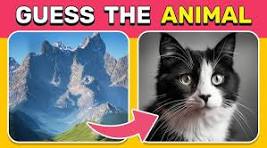Unveiling the Enigmatic World of Animal Optical Illusions
The Fascinating World of Animal Optical Illusions
Animal optical illusions are a captivating phenomenon that showcases the incredible diversity and adaptability of nature. These illusions play tricks on our eyes and minds, challenging our perception of reality and highlighting the beauty of the animal kingdom in unique ways.
Camouflage Mastery
One of the most common types of animal optical illusions is camouflage. Many animals have evolved to blend seamlessly into their surroundings, making them almost invisible to predators or prey. From the stripes of a zebra to the spots of a leopard, these natural patterns create optical illusions that confuse and deceive observers.
Mimicry and Deception
Some animals take camouflage a step further by mimicking other creatures or objects. For example, certain insects resemble leaves or twigs, while some fish mimic toxic species to deter predators. These clever adaptations demonstrate nature’s ingenuity in creating optical illusions for survival.
Size Distortion
Another intriguing aspect of animal optical illusions is size distortion. Some animals use patterns or markings to create the illusion of being larger or smaller than they actually are. This can intimidate predators or attract potential mates, showcasing how visual deception plays a crucial role in the animal kingdom.
The Evolutionary Advantage
Animal optical illusions are not just fascinating visual spectacles—they serve a vital purpose in ensuring the survival and success of various species. By mastering the art of deception through camouflage, mimicry, and size distortion, animals have adapted to their environments in remarkable ways that continue to inspire awe and wonder.
Next time you observe an animal in its natural habitat, take a closer look—you may be witnessing an incredible optical illusion crafted by evolution itself.
Understanding Animal Optical Illusions: Nature’s Tricks and Survival Strategies
- What are animal optical illusions?
- How do animals use optical illusions in nature?
- What are some examples of animal camouflage?
- Why do animals rely on optical illusions for survival?
- How do size distortion and mimicry contribute to animal optical illusions?
What are animal optical illusions?
Animal optical illusions refer to visual phenomena in the animal kingdom where creatures use various techniques to deceive or manipulate the perception of observers. These illusions can take the form of camouflage, mimicry, size distortion, or other clever adaptations that help animals survive and thrive in their environments. By leveraging patterns, colours, shapes, and behaviours, animals create illusions that confuse predators, conceal themselves from prey, or attract potential mates. These fascinating optical tricks highlight the ingenuity and diversity of nature’s design, showcasing how animals have evolved remarkable strategies to navigate their surroundings through visual deception.
How do animals use optical illusions in nature?
Animals use optical illusions in nature as a means of survival and adaptation to their environments. Through camouflage, mimicry, and size distortion, animals create visual deception that helps them evade predators, attract prey, or blend seamlessly into their surroundings. Camouflage allows animals to conceal themselves effectively, making them less visible to potential threats. Mimicry enables certain species to imitate harmful or unpalatable organisms, deterring predators through deception. Size distortion can create illusions of intimidation or attractiveness, influencing interactions with other animals. These optical strategies showcase the ingenuity of nature in equipping animals with tools for camouflage and protection in the wild.
What are some examples of animal camouflage?
Animal camouflage is a remarkable adaptation seen in various species across the animal kingdom. Examples of animal camouflage include the iconic stripes of a zebra blending into the grasslands, the cryptic patterns of a leaf insect mimicking foliage, and the intricate colouration of a chameleon matching its surroundings with remarkable precision. From the polar bear’s white fur in snowy landscapes to the stick insect’s resemblance to twigs, these examples highlight nature’s ingenious ability to conceal animals within their environments through intricate patterns and colours, showcasing the power of camouflage as a survival strategy in the wild.
Why do animals rely on optical illusions for survival?
Animals rely on optical illusions for survival as a strategic adaptation to their environments. By employing camouflage, mimicry, and size distortion techniques, animals can effectively evade predators, ambush prey, or attract mates. These optical illusions serve as a form of natural defence mechanism, allowing animals to blend into their surroundings or appear more intimidating than they actually are. Evolution has honed these deceptive strategies over time, giving animals a crucial advantage in the constant struggle for survival in the wild. Ultimately, the reliance on optical illusions showcases nature’s remarkable ability to innovate and thrive in diverse ecosystems.
How do size distortion and mimicry contribute to animal optical illusions?
Size distortion and mimicry are key elements that contribute to the fascinating world of animal optical illusions. In nature, size distortion can create the illusion of animals appearing larger or smaller than they actually are, serving as a defence mechanism against predators or a means to attract mates. On the other hand, mimicry involves animals imitating the appearance of other species or objects to deceive observers and gain a survival advantage. By utilising these techniques, animals demonstrate their remarkable adaptability and evolutionary strategies in creating visual illusions that both mesmerise and serve essential functions in their ecosystems.


